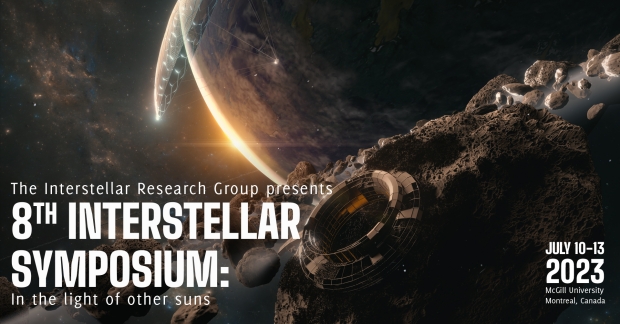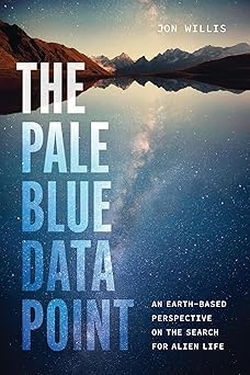Centauri Dreams
Imagining and Planning Interstellar Exploration
‘Oumuamua: Avi Loeb’s Response to the Molecular Hydrogen Theory
The enigmatic ‘Oumuamua continues to stir controversy. Last week we looked at a new paper from Jennifer Bergner (UC-Berkeley) and Darryl Seligman (Cornell University), discussing a mechanism for the interstellar object’s unusual non-gravitational acceleration. The researchers explored the possibility that ice impacted by high-energy particles like cosmic rays would dissociate water in a comet to create molecular hydrogen within the ice. Was the warming of this hydrogen, all but undetectable according to the authors, the cause of outgassing and the anomalous acceleration?
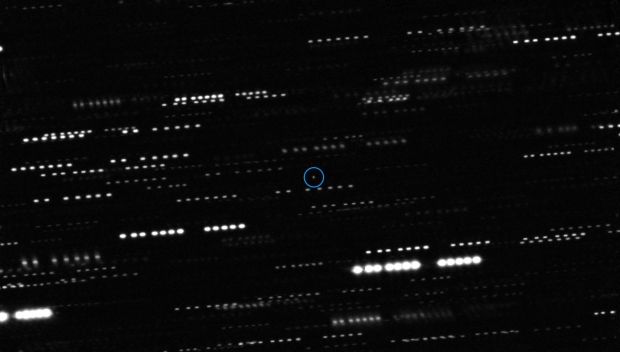
Image: This very deep combined image shows the interstellar object ‘Oumuamua at the center of the image. It is surrounded by the trails of faint stars that are smeared as the telescopes tracked the moving comet. Credit: ESO/K. Meech et al.
Answering the question in a paper just submitted to the arXiv site is Harvard’s Avi Loeb, working with Thiem Hoang (Korea University of Science and Technology), who home in on Bergner and Seligman’s finding that the surface temperature of ‘Oumuamua can exceed 140 K at perihelion, enough to produce this evaporation. Loeb and Hoang argue that this calculation ignores the effect of evaporative cooling of the molecular hydrogen. The authors proceed to take such cooling into account and find that the surface temperature of H2 water ice is lower than that calculated by Bergner and Seligman by a factor of 9. This is turn reduces the projected outgassing.
From the paper:
…we found that the evaporative cooling is much more efficient than radiative cooling at temperatures above 20 K (see Figure 1, left panel). By taking into account the evaporative cooling by H2 evaporation, our results (see Figure 1, right panel) show that the surface temperatures of H2-water ice are lower by a factor of 9 than the temperature obtained by Bergner & Seligman (2023) (see their figure 3). Therefore, the thermal speed of outgassing H2 is decreased by a factor of 3.
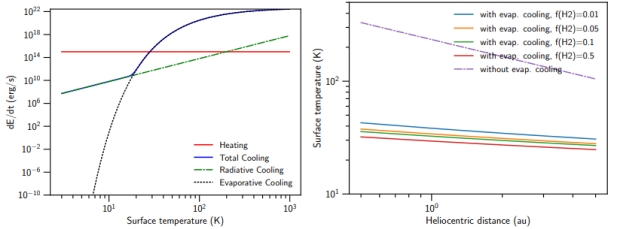
Image: This is Figure 1 from the paper. Caption: Left panel: comparison of heating and cooling rates when the object is located at 1.4 times the Earth separation from the sun. Evaporative cooling by H2 is dominant over radiative cooling. The intersection of heating and total cooling determines the equilibrium surface temperature. Right panel: surface temperature at different distances, calculated for the case with (solid lines) and without (dashed-dotted line) evaporative cooling. Different ratio of H2 to water is assumed. Evaporative cooling by H2 decreases significantly the surface temperature compared to the case without evaporative cooling (dashed-dotted line).
And this is a problem for the molecular hydrogen evaporation scenario. The result of this decrease in outgassing is that ‘Oumuamua would have had to have been what the authors call an ‘oxygen iceberg’ to produce enough molecular hydrogen to drive the observed acceleration, a highly unlikely scenario for the following reason:
Given this constraint, the requirement for a surface layer that is made of pure molecular hydrogen will not survive the journey through interstellar space as a result of heating by starlight (Hoang & Loeb 2020). Moreover, the lower surface temperature also influences the thermal annealing of water ice, a key process that is appealed to by Bergner & Seligman (2023) to release H2.
The paper is Hoang & Loeb, “Implications of evaporative cooling by H2 for 1I/‘Oumuamua” (full text).

Ring of Life? Terminator Habitability around M-dwarfs
It would come as no surprise to readers of science fiction that the so-called ‘terminator’ region on certain kinds of planets might be a place where the conditions for life can emerge. I’m talking about planets that experience tidal lock to their star, as habitable zone worlds around some categories of M-dwarfs most likely do. But I can also go way back to science fiction read in my childhood to recall a story set, for example, on Mercury, then supposed to be locked to the Sun in its rotation, depicting humans setting up bases on the terminator zone between broiling dayside and frigid night.
Addendum: Can you name the science fiction story I’m talking about here? Because I can’t recall it, though I suspect the setting on Mercury was in one of the Winston series of juvenile novels I was absorbing in that era as a wide-eyed kid.
The subject of tidal lock is an especially interesting one because we have candidates for habitable planets around stars as close as Proxima Centauri, if indeed a possibly tidally locked planet can sustain clement conditions at the surface. Planets like this are subject to extreme conditions, with a nightside that receives no incoming radiation and an irradiated dayside where greenhouse effects might dominate depending on available water vapor. Even so, moderate temperatures can be achieved in models of planets with oceans, and most earlier work has gone into modeling water worlds. I also think it’s accurate to say that earlier work has focused on how habitable conditions might be maintained in the substellar ‘eye’ region directly facing the star.
But what about planets that are largely covered in land? It’s a pointed question because a new study in The Astrophysical Journal finds that tidally locked worlds mostly covered in water would eventually become saturated by a thick layer of vapor. The study, led by Ana Lobos (UC-Irvine) also finds that plentiful land surfaces produce a terminator region that could well be friendly to life even if the equatorial zone directly beneath the star on the dayside should prove inhospitable. Says Lobo:
“We are trying to draw attention to more water-limited planets, which despite not having widespread oceans, could have lakes or other smaller bodies of liquid water, and these climates could actually be very promising.”
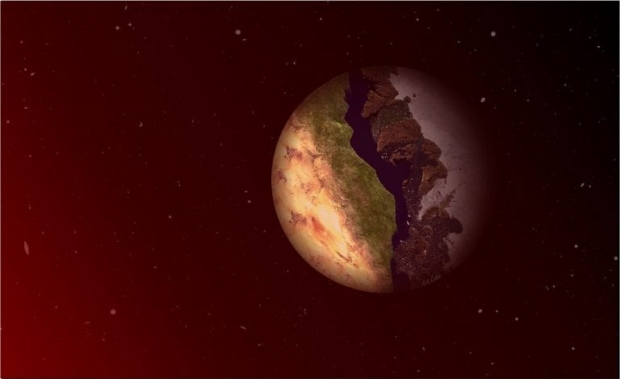
Image: Some exoplanets have one side permanently facing their star while the other side is in perpetual darkness. The ring-shaped border between these permanent day and night regions is called a “terminator zone.” In a new paper in The Astrophysical Journal, physics and astronomy researchers at UC Irvine say this area has the potential to support extraterrestrial life. Credit: Ana Lobo / UCI.
The team’s modeling simulates both water-rich and water-limited planet scenarios, even as the question of how much water to expect on a habitable zone M-dwarf planet remains open. After all, water content likely depends on planet formation. If a habitable zone planet formed in place, it likely emerged with lower water content than one that formed beyond the snowline (relatively close in for M-dwarfs) and migrated inward. We also have to remember that flare activity could trigger water loss for such worlds.
Water’s effects on climate are abundant, from affecting surface albedo to the production of clouds and the development of greenhouse effects. They’re also tricky to model when we move into other planetary scenarios. As the paper notes:
Due to water’s various climate feedbacks and its effects on the atmospheric structure, the habitable zone of a water-limited Earth twin is broader than that of an aquaplanet Earth (Abe et al. 2011). But while water’s impact on climate is well understood for Earth, many of these fundamental climate feedbacks behave differently on M-dwarf planets, due to the lower frequency of the stellar radiation.
To perform the study, Lobo’s team considered a hypothetical Earth-class planet orbiting the nearby star AD Leonis (Gliese 388), an M3.5V red dwarf, using a 3D global climate model to find out whether a tidally locked world here could sustain a temperature gradient large enough to make the terminator habitable. The study uses a simplified habitability definition based solely on surface temperature. The researchers deployed ExoCAM, a modified version of the Community Atmosphere Model (CAM4) developed by the National Center for Atmospheric Research and used to study climate conditions on Earth. Their software tweaked the original code to adjust for factors such as planetary rotation.
The results are straightforward: With abundant land on the planet, terminator habitability increases dramatically. A water-rich world like Earth, with land covering but 30 percent of the surface, is not necessarily the best model for habitability here, as we consider the factors involved in tidal lock, with extensive land offering viable options in at least part of the surface. A ‘ring’ of habitability may prove to be a common outcome for such worlds. But it’s interesting to consider how these initial conditions might complicate the early development of biology. Here I return to the paper:
There are still many uncertainties regarding the water content of habitable-zone M-dwarf planets. Based on our current understanding, it is possible that water-limited planets could be abundant and possibly more common than ocean-covered worlds. Therefore, terminator habitability may represent a significant fraction of habitable M-dwarf planets. Compared to the temperate climates obtained with aquaplanets, terminator habitability does offer reduced fractional habitability. Also, while achieving a temperate terminator is relatively easy on water-limited planets, constraining the water availability at the terminator remains a challenge. Overall, the lack of abundant surface water in these simulations could pose a challenge for life to arise under these conditions, but mechanisms, including glacier flow, could allow for sufficient surface water accumulation to sustain locally moist and temperate climates at or near the terminator.
The paper is Lobo et al., “Terminator Habitability: The Case for Limited Water Availability on M-dwarf Planets,” Astrophysical Journal Vol. 945, No. 2 (16 March 2023), 161 (full text).

A New Explanation for ‘Oumuamua’s Acceleration
Here’s a thought that puts a different spin on exoplanet studies. The speaker is Darryl Seligman (Cornell University):
“The comets and asteroids in the solar system have arguably taught us more about planet formation than what we’ve learned from the actual planets in the solar system. I think that the interstellar comets could arguably tell us more about extrasolar planets than the extrasolar planets we are trying to get measurements of today.”
Seligman’s comment plays into the growing interest in interstellar objects that drift into our Solar System like 1/I ‘Oumuamua and 2/I Borisov. These may be the initial members of what is actually a large class of debris from other stars that we are only now learning how to detect. Among the many things we have yet to refine in our understanding of ‘Oumuamua is its actual size. Projections of 115 by 111 by 19 meters are deduced from its brightness and the changes produced by its apparently tumbling motion. The interstellar interloper is too far from Earth and too small to resolve.

Image: This plot shows how the interstellar asteroid `Oumuamua varied in brightness during three days in October 2017. The large range of brightness — about a factor of ten (2.5 magnitudes) — is due to the very elongated shape of this unique object, which rotates every 7.3 hours. The different coloured dots represent measurements through different filters, covering the visible and near-infrared part of the spectrum. The dotted line shows the light curve expected if `Oumuamua were an ellipsoid with a 1:10 aspect ratio, the deviations from this line are probably due to irregularities in the object’s shape or surface albedo. Credit: ESO/K. Meech et al.
I mention this just to underline how difficult it is to make sense of ‘Oumuamua at present. Absent a fast mission to catch up with the object (and there are ideas out there, as we’ve discussed in these pages before), its dimensions will remain ambiguous. And what of the anomalous non-gravitational acceleration that astronomers noted in 2018? Seligman, who along with Gregory Laughlin has written about fast missions to ‘Oumuamua in a paper from that year, is also behind the conjecture that the object could be composed of molecular hydrogen ice. It’s no wonder, then, that his interest was piqued by Jennifer Bergner at UC-Berkeley, whose work involves chemical reactions on objects in space. And it has led to an alternative explanation for the anomalous acceleration of 1/I ‘Oumuamua, one he likes better than hydrogen ice.
Explanations for the acceleration have proliferated, many of them aimed at discrediting the concept that the object might be technological, a thought too radical for many scientists. But are ideas like hydrogen icebergs and shards of nitrogen credible in their own right? Bergner wasn’t satisfied with either pole of the controversy, and her initial work revealed that there was an explanation well documented in earlier research. Experiments beginning in the 1970s and continuing later showed what happens when ice is impacted by high-energy particles like cosmic rays. The process produces molecular hydrogen in quantity that remains trapped within the ice.
Warming up these pockets of molecular hydrogen would cause the outgassing of the H2, even if the gas were trapped tens of meters inside cometary ice. Says Bergner:
“For a comet several kilometers across, the outgassing would be from a really thin shell relative to the bulk of the object, so both compositionally and in terms of any acceleration, you wouldn’t necessarily expect that to be a detectable effect. But because ‘Oumuamua was so small, we think that it actually produced sufficient force to power this acceleration.”
That would be a helpful explanation if it can be made to fit. With the brightness of ‘Oumuamua changing periodically by a factor of 12 and varying asymmetrically, the object’s shape appeared to be elongated and its tumble was apparent. A ‘local’ comet leaving the Sun after perihelion is known to eject water and gas from its surface, producing the familiar gaseous coma and releasing dust. A dusty cometary tail forms, while a secondary tail of vapor, dust and possibly organic materials pushed by the momentum of solar photons can appear, this one pointing away from the Sun.
It was the absence of these processes that flagged ‘Oumuamua as unusual. There was no coma here, nor were outgassed molecules or dust observed, and as the authors note in their paper in Nature, solar energy hitting the object in its trajectory would not cause enough water or organic compounds to sublimate to account for the acceleration. Without a dusty coma, explaining ‘Oumuamua’s acceleration was a problem, which is why hydrogen icebergs and nitrogen shards emerged as hypotheses, for they could conceivably produce enough kick to supply the needed force.
Bergner’s search of the literature found earlier experiments where ice chilled to the temperatures of deep space is converted into molecular hydrogen by high-energy radiation. The release of that hydrogen by a heat source is sufficient, her work with Seligman confirmed, to produce a gas discharge that would affect ‘Oumuamua’s orbit. No dusty coma, then, is needed, and indeed, none is discharged by this process. Cometary ice is not sublimating but rearranging itself as H2 is released.
Seligman seems confident in the analysis:
“Jenny’s definitely right about the entrapped hydrogen. Nobody had thought of that before. Between discovering other dark comets in the solar system and Jenny’s awesome idea, I think it’s got to be correct. Water is the most abundant component of comets in the solar system and likely in extrasolar systems, as well. And if you put a water rich comet in the Oort cloud or eject it into the interstellar medium, you should get amorphous ice with pockets of H2.”
And in fact, working with Bergner, Seligman and colleagues have identified six other comets that lack an observable coma but demonstrate small non-gravitational accelerations. Usefully, one of these is comet 1998 KY26, which is targeted by Japan’s Hayabusa2 mission, the same mission that collected samples of the asteroid Ryugu. It was only in December of 2022 that 1998 KY26 was identified as a comet rather than an asteroid. Is hydrogen outgassing like this in fact common to deep space comets? The Rubin Observatory Legacy Survey of Space and Time (LSST), which will go into operation in 2025, may give us a notion of the distribution of such objects.
The paper is Bergner and Seligman, “Acceleration of 1I/‘Oumuamua from radiolytically produced H2 in H2O ice,” Nature 22 March 2023 (abstract).

Interstellar Research Group: 8th Interstellar Symposium Second Call for Papers
Abstract Submission Final Deadline: April 21, 2023
The Interstellar Research Group (IRG) in partnership with the International Academy of Astronautics (IAA) hereby invites participation in its 8th Interstellar Symposium, hosted by McGill University, to be held from Monday, July 10 through Thursday, July 13, 2023, in Montreal, Quebec, Canada. This is the first IRG meeting outside of the United States, and we are excited to partner with such a distinguished institution!
Topics of Interest
Physics and Engineering
Propulsion, power, communications, navigation, materials, systems design, extraterrestrial resource utilization, breakthrough physics
Astronomy
Exoplanet discovery and characterization, habitability, solar gravitational focus as a means to image exoplanets
Human Factors
Life support, habitat architecture, worldships, population genetics, psychology, hibernation, finance
Ethics
Sociology, law, governance, astroarchaeology, trade, cultural evolution
Astrobiology
Technosignature and biosignature identification, SETI, the Fermi paradox, von Neumann probes, exoplanet terraformation
Submissions on other topics of direct relevance to interstellar travel are also welcome. Examples of presentations at past symposia can be found here:
https://www.youtube.com/c/InterstellarResearchGroup/videos
Confirmed Speakers
Dr. Stephen Webb (University of Portsmouth)
“Silence is Golden: SETI and the Fermi Paradox”
Dr. Kathryn Denning (York University)
“Anthropological Observations for Intestellar Aspirants”
Dr. Rebecca M. Rench (Planetary Science Division, NASA Headquarters)
“The Search for Life and Habitable Worlds at NASA: Past, Present and Future”
Dr. Frank Tipler (Tulane University)
“The Ultimate Rocket and the Ultimate Energy Source and their Use in the Ultimate Future”
Contributed Plenary Lectures
The primary submissions for the Interstellar Symposium are plenary lectures. The lectures will be approximately 20 minutes in length and be accompanied by a manuscript prior to the Symposium. The early bird deadline for abstract submission, which ensures expedited consideration and notification of acceptance, is January 15, 2023. Submitted abstracts will continue to be considered until April 21, 2023, if space in the program permits. The submitted abstract should follow the format described in the Abstract Submission section below. Abstracts should be emailed to: registrar@irg.space
No Paper, No Podium: Contributed plenary lectures are to be accompanied by a written paper, with an initial draft due June 23, 2023. You will have an opportunity to revise and extend your draft before the publication deadline of September 8, 2023. If a paper is not submitted by the final manuscript deadline, authors will not be permitted to present their work. Papers should be original work that has not been previously published.
Work in Progress Posters
Contributors wishing to present projects still in progress or at a preliminary stage may submit an abstract for a Work in Progress poster presentation. The deadline for abstract submission for Work in Progress posters is May 20, 2023. The abstract describing the work to be presented should follow the format described in the Abstract Submission section below. The poster should not exceed 36 inch (width) by 48 inch (height). The presenters are responsible for printing their own posters and would need to bring their poster to the Interstellar Symposium. Abstracts should be emailed to: registrar@irg.space
Sagan Meetings
An interested Sagan Meeting organizer is given the option to define a particular question for an in-depth panel discussion. The organizer would be responsible for inviting five speakers to give short presentations staking out a position on a particular question. These speakers will then form a panel to engage in a lively discussion with the audience on that topic. Carl Sagan famously employed this format for his 1971 conference at the Byurakan Observatory in old Soviet Armenia, which dealt with the Drake Equation. A one-page description (format of your choosing) of the panel topic, the questions to be addressed, and the suggested panel members should be emailed by January 15, 2023 to: registrar@irg.space
Seminars
Seminars are 3-hour presentations on a single subject, providing an in depth look at that subject. Seminars are held before the Symposium begins, on Sunday, July 9, 2023, with morning and afternoon sessions. The content must be acceptable to be counted as continuing education credit for those holding a Professional Engineer (PE) certificate.
Other Content
Other content includes, but is not limited to, posters, displays of art or models, demonstrations, panel discussions, interviews, or public outreach events. IRG recognizes the importance of a holistic human cultural experience and encourages the submission of non-academic works to be involved with the symposium program.
Publications
The IRG serves as a critical incubator of ideas for the interstellar community. Following the success of the 7th Interstellar Symposium, papers may be submitted for consideration in publication within a special issue of Acta Astronautica. Papers from the 7th Symposium (September 2021) have now been published in the August 2022 issue of Acta Astronautica. Contributors who wish to publish their papers elsewhere may do so. Abstracts and papers not published elsewhere will be compiled into a complete Symposium proceedings in book form.
Video and Archiving
All symposium events may be captured on video or in still images for use on the IRG website, in newsletters and social media. All presenters, speakers, and selected participants will be asked to complete a Release Form that grants permission for IRG to use this content as described.
Abstract Submission
Abstracts for the 8th Interstellar Symposium must relate to one or more of the many interstellar mission related topics. The previously listed topics are not exclusive but represent a cross-section of possible categories. All abstracts must be submitted online via email to: registrar@irg.space.
Acceptable formats are text, Microsoft Word, and PDF only. Submissions of Contributed Plenary Lectures and Work in Progress Posters must follow the format described below.
Presenting Author(s)
Please list only the author(s) who will actually be in attendance and presenting at the conference. (First name, last name, degree – for example, Susan Smith, MD)
Additional Author(s)
List all authors here, including Presenting Author(s) – (first name, last name, degree(s) – for example, Mary Rockford, RN; Susan Smith, MD; John Jones, PhD)
Abbreviation(s)
Abbreviations within the body should be kept to a minimum and must be defined upon first use in the abstract by placing the abbreviation in parenthesis after the represented full word or phrase. Non-proprietary (generic) names should be used.
Abstract Length
The entire abstract (excluding title, authors, presenting author’s institutional affiliation(s), city, state, and text) including any tables or figures should be a maximum of 350 words. It is your responsibility to verify compliance with the length requirement.
Abstract Structure
Abstracts must include the following headings:
- Title = The presentation title.
- Background = Describes the research or initiative context.
- Objective = Describes the research or initiative objective.
- Methods = Describes research methodology used. For initiatives, describes the target population, program or curricular content, and evaluation method.
- Results – Summarizes findings in sufficient detail to support the conclusions.
- Conclusion – States the conclusions drawn from results, including their applicability.
Questions and responses to this call for papers, workshops, and participation should be directed to:
For updates on the meeting, speakers, and logistics, please refer to the website:

Alpha Centauri: TOLIMAN Moves Forward
The problem with Alpha Centauri is that the system is too close. I don’t refer to its 4.3 light year distance from Sol, which makes these stars targets for future interstellar probes, but rather the distance of the two primary stars, Centauri A and B, from each other. The G-class Centauri A and K-class Centauri B orbit a common barycenter that takes them from a maximum of 35.6 AU to 11.2 AU during the roughly 80 year orbital period. That puts their average distance from each other at 23 AU.
So the average orbital distance here is a bit further than Uranus’ orbit of the Sun, while the closest approach takes the two stars almost as close as the Sun and Saturn. Habitable zone orbits are possible around both stars, making for interesting scenarios indeed, but finding out just how the system is populated with planets is not easy. We’ve learned a great deal about Proxima Centauri’s planets, but teasing out a planetary signature from our data on Centauri A and B has been frustrating despite many attempts. Alpha Centauri Bb, announced in 2012, is no longer considered a valid detection.
But the work continues. I was pleased to see just the other day that Peter Tuthill (University of Sydney) is continuing to advance a mission called TOLIMAN, which we’ve discussed in earlier articles (citations below). The acronym here stands for Telescope for Orbit Locus Interferometric Monitoring of our Astronomical Neighborhood, a mission designed around astrometry and a small 30cm narrow-field telescope. The project has signed a contract with Sofia-based satellite and space services company EnduroSat, whose MicroSat technology can downlink data at 125+ Mbps, and if the mission goes as planned, there will be data aplenty.

Image: Alpha Centauri is our nearest star system, best known in the Southern Hemisphere as the bottom of the two pointers to the Southern Cross. The stars are seen here in optical and x-ray spectra. Source: NASA.
The technology here is quite interesting, and a departure from other astrometry missions. Astrometry is all about tracking the minute changes in the position of stars as they are affected by the gravitational pull of planets orbiting them, a series of angular displacements that can result in calculations of the planet’s mass and orbit. Whereas both transit and radial velocity methods work best when dealing with planets close to their star, astrometry is the reverse, becoming more effective with separation.
Finding an Earth-class planet in the habitable zone around one of these two stars requires us to identify a signal in the range of 2.5 micro-arcseconds for Centauri A, an amount that is halved for a planet around Centauri B. Not an easy catch, but the ingenious TOLIMAN technology uses a ‘diffractive pupil’ to spread the starlight and increase the ability to spot and subtract systematic errors. I’ve quoted the team’s online description before but it usefully encapsulates the method, which has no need of field stars as references because it uses the binary companion to the star being examined as a reference, making a small aperture suitable for the work.
With the fortuitous presence of a bright phase reference only arcseconds away, measurements are immediately 2 – 3 orders of magnitude more precise than for a randomly chosen bright field star where many-arcminute fields (or larger) are required to find background stars for this task. Maintaining the instrument imaging distortions stable over a few arcseconds is considerably easier than requiring similar stability over arcminutes or degrees. Alpha Cen’s proximity to Earth means that the angular deviations on the sky are proportionately larger (typically a factor of ~10-100 compared to a population of comparably bright stars).
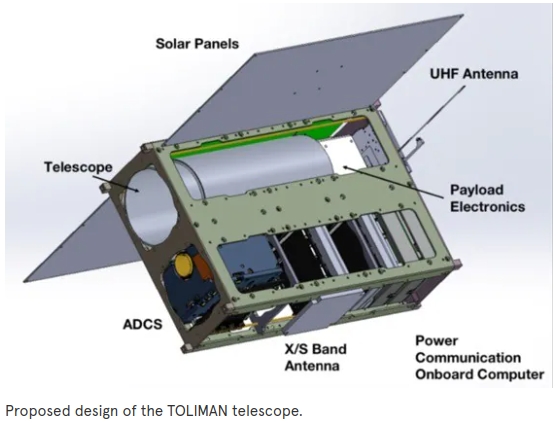
Image: Telescope design: The proposed TOLIMAN space telescope with a candidate telescope mirror pattern known as a diffractive pupil. Rather than concentrating the starlight into a tight focused beam as is usually done for optical systems, TOLIMAN has a strongly featured pattern, spreading starlight into a complex flower pattern that, paradoxically, makes it easier to register the fine detail required in the measurement to detect the small wobbles a planet would make in the star’s motion. Credit: Peter Tuthill / University of Sydney.
You can imagine the thermal and mechanical stability issues involved here. Doubtless Tuthill’s experience in the design of NIRISS (Near-Infrared Imager and Slitless Spectrograph ) and the aperture masking interferometry for the instrument on the James Webb Space Telescope will inform the evolution of the TOLIMAN hardware. As to EnduroSat, Raycho Raychev, founder and CEO, has this to say:
“We are exceptionally proud to partner in this mission. The challenges are enormous, and it will drive our engineering efforts to the extreme. The mission is a first-of-its-kind exploration science effort and will help open the doors for low-cost astronomy missions.”
A successful TOLIMAN mission could lead to what the team has referred to as TOLIMAN+, a larger instrument capable of detecting Earth-class worlds around both 61 Cygni and 70 Ophiuchi. But let’s get the Alpha Centauri results first, perhaps leading to detections around a target whose planetary signals would be much stronger than those of these other systems. We’ve seen how larger instruments like those aboard HIPPARCOS and Gaia have used astrometry to upgrade our view of vast numbers of stars, but it may be a small, dedicated mission with a unique technology that finally settles the question of planets around the two nearest Sun-like stars.
For more on TOLIMAN, see two previous posts: TOLIMAN Targets Centauri A/B Planets and TOLIMAN: Looking for Earth Mass Planets at Alpha Centauri. Also see this useful backgrounder.

The Latest from New Horizons
New Horizons is, like the two Voyagers, a gift that keeps on giving, even as it moves through the Kuiper Belt in year 17 of its mission. Thus the presentations that members of the spacecraft team made on March 14 at the 54th Lunar and Planetary Science Conference. Papers will flow out of these observations, including interpretations of the twelve mounds on the larger lobe of Arrokoth, the contact binary that is being intensely studied through stereo imaging to identify how these features formed around a larger center mound. Alan Stern (SwRI) is principal investigator for the New Horizons mission:
“We discovered that the mounds are similar in many respects, including their sizes, reflectivities and colors. We believe the mounds were likely individual components that existed before the assembly of Arrokoth, indicating that like-sized bodies were formed as precursors to Arrokoth itself. This is surprising, and a new piece in the puzzle of how planetesimals – building blocks of the planets, like Arrokoth and other Kuiper Belt objects come together.”
Science team members also discussed the so-called ‘bladed terrain,’ evidently the product of methane ice, that seems to stretch across large areas of Pluto’s ‘far side,’ as observed during the spacecraft’s approach. It was intriguing to learn as well about the spacecraft’s observations of Uranus and Neptune, which will complement Voyager imaging at different geometries and longer wavelengths. And Pluto’s ‘true polar wander’ (the tilt of a planet with respect to its spin axis came into play (and yes, I do realize I’ve just referred to Pluto as a ‘planet’). Co-investigator Oliver White:
“We’re seeing signs of ancient landscapes that formed in places and in ways we can’t really explain in Pluto’s current orientation. We suggest the possibility is that they formed when Pluto was oriented differently in its early history, and were then moved to their current location by true polar wander.”

Image: Pluto’s Sputnik Planitia, the huge impact basin found in Pluto’s ‘heart’ region, seems to have much to do with the world’s axial tilt, while the possibility of a deep ocean pushing against the basin from below has to be taken into account. This image is from the presentation by Oliver White (SETI Institute) at LPSC. Credit: NASA/Johns Hopkins APL/SwRI/James Tuttle Keane.
But let me pause today on the quest for other Kuiper Belt Objects as the search for a second flyby candidate continues. Not that a flyby is essential. Using the Japanese Subaru Telescope in Hawaii and the Victor M. Blanco instrument at Cerro Tololo, the team is now applying a deep learning algorithm (a ‘convolutional neural network’) to analyze imagery. Wes Fraser, a member of the science team, is quoted on the New Horizons site as saying “The software network’s classification performance is extremely good, significantly cutting back on ‘false’ candidate sources. An entire night’s worth of search data requires only a few hours of human vetting. Compare that to the weeks it used to take to do this!”

Image: A “stack” of images from one night of observing with the Subaru Telescope’s Hyper Suprime-Cam, showing myriad stars that illustrate the difficulty of spotting an undiscovered Kuiper Belt object. The animation below shows movement – across the center-right of the frame — of a newly discovered KBO in one of these images. Credit: NASA/Johns Hopkins APL/Southwest Research Institute/Subaru Telescope.
The point is that we’re learning a great deal about KBOs even in the absence of another flyby, discovering a surprising number of objects like that shown (look carefully) in the animation below. The Subaru Telescope produced, with its wide field of view, some 87 new KBOs in 2020 in the direction of the spacecraft’s trajectory. It was heartening to learn that running that same data through the new software enabled a search that was both 100 times faster but also revealed another 67 KBOs. Some of these – and about 20 will be close enough to observe from a distance of millions of miles – should be grist for the mill as New Horizons examines them in the coming two years.
Image: This animation shows movement—across the center-right of the frame—of a newly discovered Kuiper Belt object in one of the Subaru Telescope Hyper Suprime-Cam images. Credit: NASA/Johns Hopkins APL/Southwest Research Institute/Subaru Telescope.
Will JHU/APL’s Interstellar Probe design eventually be approved and join the spacecraft now departing our Solar System? Or will JPL’s Solar Gravity Lens mission to the gravitational focus become our next deep space sojourner? As we ponder mission designs and the likelihood of their approval, keeping an eye on our existing assets in deep space reminds us of the outstanding science return we’ve achieved thus far.

